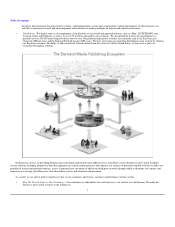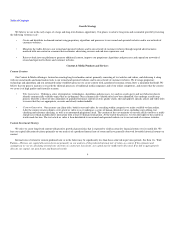Enom 2010 Annual Report Download - page 19
Download and view the complete annual report
Please find page 19 of the 2010 Enom annual report below. You can navigate through the pages in the report by either clicking on the pages listed below, or by using the keyword search tool below to find specific information within the annual report.
Table of Contents
from search engines came from Google), according to our internal data. Our ability to maintain the number of visitors directed to our owned and operated
websites and to our customers' websites through which we distribute our content by search engines is not entirely within our control. For example, search
engines frequently revise their algorithms in an attempt to optimize their search result listings. Recently, Google announced an algorithm change that affected
nearly 12% of their U.S. query results. Although to date we have not experienced a material net impact on our content and media business as a result of this
change, there cannot be any assurance as to whether these or any future changes that may be made by Google or any other search engines might impact our
business in the long term. Changes in the methodologies used by search engines to display results could cause our owned and operated websites or our
customer websites to receive less favorable placements, which could reduce the number of users who link to our owned and operated websites and to our
customers' websites from these search engines. Some of our owned and operated websites and our customers' websites have experienced fluctuations in search
result rankings and we anticipate similar fluctuations in the future. Internet search engines could decide that content on our owned and operated websites and
on our customers' websites, including content that is created by our freelance content creators, is unacceptable or violates their corporate policies. Any
reduction in the number of users directed to our owned and operated websites and to our customers' websites would negatively affect our ability to earn
revenue. If traffic on our owned and operated websites and on our customers' websites declines, we may need to resort to more costly sources to replace lost
traffic, and such increased expense could adversely affect our business, revenue, financial condition and results of operations.
We base our capital allocation decisions primarily on our analysis of the predicted internal rate of return on content. If the estimates and assumptions we
use in calculating internal rate of return on content are inaccurate, our capital may be inefficiently allocated. If we fail to appropriately allocate our
capital, our growth rate and financial results will be adversely affected.
We invest in content based on our calculation of the internal rate of return on previously published content cohorts for which we believe we have
sufficient data. For purposes of these calculations, a content cohort is all of the content we publish in a particular quarter. We calculate the internal rate of
return on a cohort of content as the annual discount rate that, when applied to the advertising revenue, less certain direct ongoing costs, generated from the
cohort over a period of time, produces an amount equal to the initial investment in that cohort. Our calculations are based on certain material estimates and
assumptions that may not be accurate. Accordingly, the calculation of internal rate of return may not be reflective of our actual returns. The material estimates
and assumptions upon which we rely include estimates about portions of the costs to create content and the revenue allocated to that content. We make
estimates regarding when revenue for each cohort will be received. Our internal rate of return calculations are highly dependent on the timing of this revenue,
with revenue earned earlier resulting in greater internal rates of return than the same amount of revenue earned in subsequent periods.
We use more estimates and assumptions to calculate the internal rate of return on video content because our systems and processes to collect historical
data on video content are less robust. As a result, our data on video content may be less reliable. If our estimates and calculations do not accurately reflect the
costs or revenues associated with our content, the actual internal rate of return of a cohort may be more or less than our estimated internal rate of return for
such cohort. In such an event, we may misallocate capital and our growth, revenue, financial condition and results of operations could be negatively impacted.
17
























